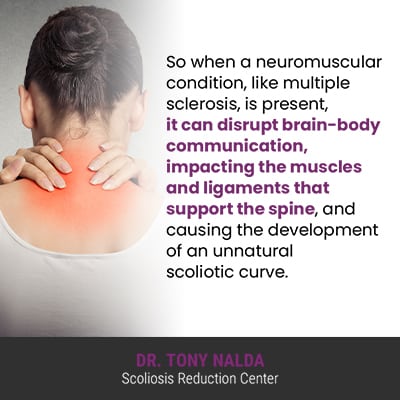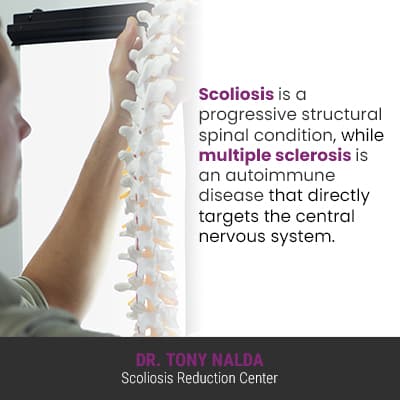Can Scoliosis Lead To Multiple Sclerosis? [ANSWERED]
![Can Scoliosis Lead To Multiple Sclerosis [ANSWERED]](https://drtonynalda.com/wp-content/uploads/2023/05/Can-Scoliosis-Lead-To-Multiple-Sclerosis-ANSWERED.jpg)
Scoliosis is a structural condition of the spine, while multiple sclerosis is a disease of the central nervous system (CNS). Neuromuscular scoliosis (NMS) is caused by the presence of a larger neuromuscular condition, like multiple sclerosis (MS), and because the scoliosis develops as a secondary complication, the underlying neuromuscular condition has to be the guiding force of treatment.
There is not just one type of scoliosis, and the spinal condition can also develop due to the presence of a larger condition, such as multiple sclerosis. As a disease of the central nervous system, multiple sclerosis can lead to the development of neuromuscular scoliosis, but not vice versa.
Let’s start our exploration of the connection between multiple sclerosis and scoliosis by first defining each condition.
Table of Contents
What is Scoliosis?
Scoliosis is a highly-prevalent structural spinal condition; in fact, according to the Scoliosis Research Society, there are close to seven million people currently living with scoliosis in the United States alone.
Scoliosis is also the most prevalent spinal condition amongst school-aged children.
In order to be diagnosed with scoliosis, certain parameters have to be met: an unnatural sideways spinal curve has developed, that also rotates, making it a complex 3-dimensional condition, and the curve has to be at least 10 degrees.
Curvature size is measured in degrees and is known as Cobb angle, and a patient’s Cobb angle is a key piece of information that tells me how far out of alignment their spine is, in addition to classifying the condition in terms of severity:
- Mild scoliosis: Cobb angle measurement of between 10 and 25 degrees
- Moderate scoliosis: Cobb angle measurement of between 25 and 40 degrees
- Severe scoliosis: Cobb angle measurement of 40+ degrees
- Very-severe scoliosis: Cobb angle measurement of 80+ degrees
As you can see, scoliosis ranges widely in severity, and the severity levels are also the condition’s progressive line.
Scoliosis is Progressive
Scoliosis being progressive means that its nature is to worsen over time, so even scoliosis diagnosed as mild can easily progress to moderate or severe, especially if left untreated, or not treated proactively.
Scoliosis progressing means the unnatural spinal curve is increasing in size, and the body is being exposed to more and more uneven forces, and in addition, the spine becomes more rigid, making it less responsive to treatment.
The spine’s surrounding muscles are also affected by scoliosis progression, and the larger a scoliotic curve gets, the more unbalanced the muscles surrounding the spine become, with the muscles on one side of the spine becoming stretched and loose from overuse, while the muscles on the opposite side can become weak from underuse.
While there are never treatment guarantees, early detection, when met with proactive treatment started as close to the time of diagnosis as possible, does increase the chances of treatment success.
As mentioned, there are also different types of scoliosis, and while idiopathic scoliosis is the most common, accounting for 80 percent of diagnosed cases, the remaining 20 percent are types associated with known causes: degenerative scoliosis, congenital scoliosis, and neuromuscular scoliosis.
Neuromuscular Scoliosis
In typical cases of scoliosis, the unnatural spinal curve bends to the right, away from the heart, but in atypical cases, as in neuromuscular scoliosis, the curve bends to the left, towards the heart.
When I see this, it’s a red flag for me that the scoliosis is caused by an underlying pathology, and in the case of neuromuscular scoliosis, that’s the presence of a larger neuromuscular condition, like spina bifida, muscular dystrophy, or multiple sclerosis.
In cases of neuromuscular scoliosis, I can’t give my patients the same types of prognoses as in typical cases because the larger neuromuscular condition has to be addressed, complicating the treatment process.
In neuromuscular scoliosis patients, there is a disruption in the connection between the brain and the muscles and/or connective tissues that support the spine, and like scoliosis, this can range in severity, with some patients becoming nonambulatory and wheelchair bound.
 So when a neuromuscular condition, like multiple sclerosis, is present, it can disrupt brain-body communication, impacting the muscles and ligaments that support the spine, and causing the development of an unnatural scoliotic curve.
So when a neuromuscular condition, like multiple sclerosis, is present, it can disrupt brain-body communication, impacting the muscles and ligaments that support the spine, and causing the development of an unnatural scoliotic curve.
While not everyone with multiple sclerosis is guaranteed to develop neuromuscular scoliosis, it is a common complication.
What is Multiple Sclerosis?
The body’s central nervous system consists of the brain and spinal cord and is a complex communication network that facilitates brain-body communication; as such, the central nervous system is involved in the function of virtually every system at work within the body.
Multiple sclerosis is an autoimmune disease of the central nervous system and involves the body’s immune system attacking the protective coating that encases nerve fibers (myelin sheath), and this disrupts brain-body communication.
Multiple sclerosis can lead to permanent nerve damage and/or deterioration occurring over time and ranges widely in severity.
Experienced symptoms will depend on a number of factors such as patient age, condition severity, and the degree of nerve involvement.
Some patients will lose the ability to walk unassisted, while others can have periods of remission and flare ups of symptoms.
In addition to the risk of developing neuromuscular scoliosis, multiple sclerosis patients can develop additional complications such as muscle spasms, muscle pain, stiff muscles, bladder and/or bowel issues, issues with sexual function, leg paralysis, and changes to mental health.
Living with a progressive condition is a large weight to carry, and too often, the impact on mental health is underestimated; while each case is unique, those suffering from severe multiple sclerosis are known to struggle with brain fog, memory issues, and depression.
Treatment for multiple sclerosis centers around helping patients recover from flare ups, lengthen periods of remission, and manage the disease’s progression and symptoms.
Multiple Sclerosis and Scoliosis
Now that we’ve defined both scoliosis and multiple sclerosis, and how multiple sclerosis can lead to the development of neuromuscular scoliosis as a related complication, let’s talk about some other connections.
Both multiple sclerosis and scoliosis involve the central nervous system, and the cause of both conditions isn’t fully understood, at least in typical forms of scoliosis; both are thought to be mainly multifactorial, meaning caused by a combination of multiple factors that can vary from person to person.
In addition, both conditions can range widely in severity, are progressive and incurable, and can develop a number of symptoms and complications, especially if left untreated.
In order for any type of treatment of neuromuscular scoliosis to start, its underlying cause has to first be addressed, which is multiple sclerosis.
The key difference is that in typical cases of idiopathic scoliosis, the condition is structural, so while it impacts the central nervous system, it is not a central nervous system disorder in and of itself, but multiple sclerosis is.
 Scoliosis is a progressive structural spinal condition, while multiple sclerosis is an autoimmune disease that directly targets the central nervous system.
Scoliosis is a progressive structural spinal condition, while multiple sclerosis is an autoimmune disease that directly targets the central nervous system.
Conclusion
So can scoliosis lead to multiple sclerosis: no, but multiple sclerosis can lead to the development of neuromuscular scoliosis as a related complication.
Patients with multiple sclerosis tend to experience a lot of spinal degeneration, and this is caused by asymmetric weakness in the muscles/ligaments that surround the spine and provide it with support and stabilization.
In severe cases of scoliosis, and/or in cases that are left untreated to progress, muscle imbalance can also develop: another similarity between multiple sclerosis and scoliosis.
As multiple sclerosis involves the immune system attacking the protective coating around the nerve fibers, this disrupts the messages those nerves are relaying, and this can cause a number of issues.
As multiple sclerosis impairs the ability of the central nervous system to send and receive important signals and messages, the muscles and connective tissues needed to support the spine’s natural curves are targeted, and this means the spine is not getting the support it needs.
It’s not just the spine that’s in charge of maintaining its natural curves and alignment; it needs help from its surroundings, and when the spine is not optimally supported and stabilized, its vertebrae can shift out of alignment, causing the onset of neuromuscular scoliosis.
In cases of neuromuscular scoliosis caused by multiple sclerosis, as the MS is the more dominant underlying condition, scoliosis won’t lead to the development of multiple sclerosis, but multiple sclerosis can cause the development of neuromuscular scoliosis, and a number of other complications.
Here at the Scoliosis Reduction Center, while there are never treatment guarantees, I’ve treated all types of scoliosis, including neuromuscular scoliosis, and while this is a complex condition and treatment needs to focus on the larger neuromuscular condition, in many cases, improvements can be worked towards.
Dr. Tony Nalda
DOCTOR OF CHIROPRACTIC
After receiving an undergraduate degree in psychology and his Doctorate of Chiropractic from Life University, Dr. Nalda settled in Celebration, Florida and proceeded to build one of Central Florida’s most successful chiropractic clinics.
His experience with patients suffering from scoliosis, and the confusion and frustration they faced, led him to seek a specialty in scoliosis care. In 2006 he completed his Intensive Care Certification from CLEAR Institute, a leading scoliosis educational and certification center.
About Dr. Tony Nalda
 Ready to explore scoliosis treatment? Contact Us Now
Ready to explore scoliosis treatment? Contact Us Now





